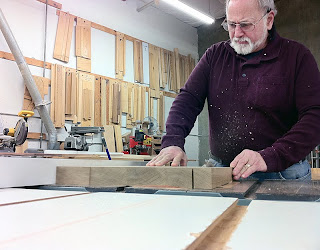Gerrit Rietveld died in 1964 at the age of 76. he designed the Steltman chair just a year earlier.
(Text via Radio Netherlands Worldwide)
What’s the point of a chair that isn’t comfortable to sit on? Gerrit Rietveld designed his furniture with ordinary people in mind, but they must have asked themselves this question. Straight lines, primary colours and a rigid, hard seat. The world-acclaimed Dutch furniture designer and architect dreamed of mass production, but instead, his work was embraced by the elite. His grandson Egbert ensures that Rietveld furniture is still available throughout the world.
“In 2008, I was at a design fair in Japan. I saw thousands of Japanese visitors passing through each day. Often, when they looked at the ‘Red and Blue Chair’ or the ‘Military’ chair, they’d say, “Rietveld”. Strange that so many people immediately recognised his work.”
Egbert Rietveld works at the airline, KLM, but has also set up a company to make and sell furniture designed by his grandfather.
Egbert Rietveld, and a Steltman chair (possibly life size)
Gerrit Rietveld (1888-1964) enjoyed world fame as an architect and furniture designer. His ‘Red and Blue Chair’ (1918) has become a real icon, and possibly the most copied chair in the world.
Rietveld kept in touch with many innovative architects and artists at home and abroad. They shared ideas and sought to explore together unknown territory in the world of design. The architect joined an artists’ movement called 'De Stijl' in 1919. The painter Piet Mondriaan was also a member.
They used straight lines and mostly primary colours, alongside black, white and grey. Rietveld hoped that his simple designs would catch on with the general public.
Grandson Egbert adds:
“He was always concerned with production. For ordinary people. He didn’t want his products to be expensive and simple. He made one mistake: the public ignored him. Ordinary people thought his chair was too simple, too clean-lined, too Spartan. Maybe even too cheap…like his ‘crate’ furniture during the Depression, which could be bought in kit form or just as a drawing, to assemble yourself from bits of spare wood. But this type of furniture was only bought by the very rich.”
Later in his career, Rietveld distanced himself somewhat from the strict guidelines of the movement. Ida van Zijl: “Rietveld did say that he first had to break everything down, go right back to basics. Later, he began to feel freer in his quest for the perfect use of space. Then came the return of organic materials and round, more fluent form in his work.”
Rietveld went on to experiment with different styles, but it’s his work from the De Stijl period for which he received worldwide acclaim. He also used curved triplex and tubes in his furniture. A small Italian company manufactures some of these designs. But Egbert Rietveld wanted to see more of his grandfather’s work on the market. So, he set up
Rietveld-by-Rietveld and has attracted customers from all over the world. No imitation, he stresses, but simply production. True to the spirit of his grandfather.















































